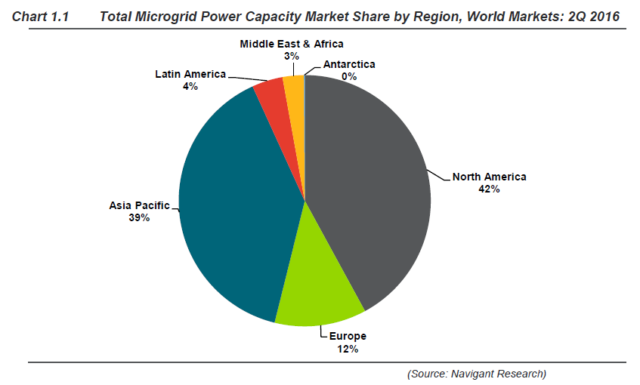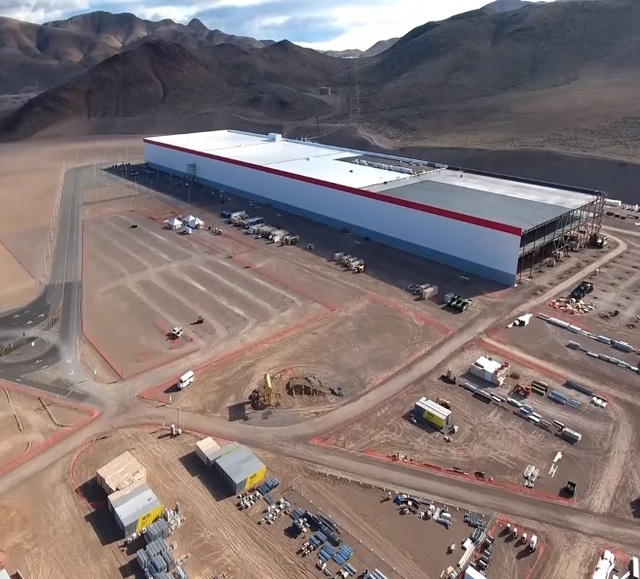>> Microgrids

– North America Leads World in Microgrid Capacity
Microgrid deployments are on the rise around the world. Navigant Research identified 1,568 projects with a collective capacity of more than 15 GW in producing its 2Q16 Microgrid Deployment Tracker. Navigant added 148 microgrid projects either in the proposal, planning, or deployment phases or fully installed since it last updated its database in December.
More than half the total new capacity of nearly 2 GW worth of microgrid projects are in North America, which regained the leading position among world regions from Asia-Pacific as of end 2Q.
Gains in remote, off-grid and utility microgrid projects fueled the rise. “The remote microgrid segment’s growing dominance in the microgrid market shows the increasing visibility in the Middle East and African region as well as the Latin American and Asia Pacific regions where remote microgrids are common,” says research associate Adam Wilson. “Additionally, one-fourth of new capacity coming from utility distribution microgrids shows the markets gradual and continuing shift of microgrid developers looking more to utilities instead of traditional third-party vendors.”
– Port of Los Angeles Invests in a Hybrid Microgrid
The Port of Los Angeles and Pasha Stevedoring and Terminals L.P. aim to demonstrate the feasibility of using a zero- or near-zero-emissions hybrid microgrid to reliably and cost-effectively power large industrial facilities.
A hybrid microgrid that incorporates on-site solar PV electricity generation, battery-based energy storage and an energy management system capable is the centerpiece of the project partners’ Green Omni Terminal, ¨a full-scale, real-time demonstration of zero- and near-zero-emission technologies at a working marine terminal,¨ a news report explains.
“This is a Wright Brothers moment,” says Pasha SVP Jeffrey Burgin. “We’re going to be the proving ground to change the paradigm of how large industrial facilities can run on clean energy. We’re confident we can show this is absolutely attainable.¨ Adds Los Angeles May Eric Garcetti: “The Port of Los Angeles is leading the world toward a sustainable future, and today we’re raising the bar again.”
Added Los Angeles May Eric Garcetti: “The Port of Los Angeles is leading the world toward a sustainable future, and today we’re raising the bar again.”
– Duke Energy Tests New Open Field Message Bus at Microgrid Test Bed
Currently in lab and pre-production testing at Duke Energy’s Mount Holly microgrid test bed in North Carolina, the new standards-based communications technology is designed to enhance the speed at which data traverses distributed generation, microgrid, and smart grid systems, thereby enhancing overall performance, a news report highlights.
Duke Energy’s Emerging Technologies group is testing the new data communications bus’ ability to transfer data to and from a 110 kW solar PV and 250 kW battery energy storage system.
Solar PV output can drop from 100 to 30 percent in a matter of seconds when clouds cross a facility, says Duke Energy’s Tom Fenimore. “You can’t respond fast enough with traditional architecture to make fast decisions; you’ll never catch up. In that case, you won’t get the most out of the solar or your battery.”
Duke’s Open Field Message Bus technology can also enhance interoperability among the numerous and varied microgrid and distributed energy and smart grid technology offered by vendors. The challenge is convincing vendors to accept and make use of the technology.
“Every manufacturer chooses different communication protocols,” Fenimore explains. ¨It’s like trying to drop a Toyota engine into a Ford; they’re not compatible…The communication protocols and the way the vendors choose to map the information are different from one manufacturer to another – S&C Electric and Schneider Electric, for example; each requires a specific way to communicate with their equipment.”
Duke Energy’s new communications bus could resolve the issue, he adds. “It makes this process of communicating with all these devices a seamless effort. It makes the effort more cost-effective and easier.”
> International
– CHP Microgrid for U.S. Army Base in Germany
The U.S. Defense Logistics Agency (DLA) signed a $24.6 million contract with Siemens to build, operate and maintain a Combined Heat & Power (CHP) microgrid at U.S. Army Installation Management Command (IMCOM) headquarters in Semback, Germany, according to a news report.
DLA and IMCOM project the CHP microgrid will reduce energy costs by one-third and indirect greenhouse gas (GHG) emissions 26 percent while enhancing energy security at the same time. The project is Siemens’ first energy savings performance contract (ESPC) at a U.S. military facility outside the U.S.
>> Energy Storage

– U.S. Energy Storage Deployments Soar 127% in 1Q
U.S. energy storage deployments rose 127 percent year-over-year (YoY) in 1Q’16, according to GTM Research and Energy Storage Association’s (ESA) latest U.S. Energy Storage Monitor. That’s a drop of 84 percent from the record-setting pace in 4Q 2015, GTM notes in a news report, continuing an emerging trend of slow 1Q starts.
New residential energy storage deployments stood out both quarterly and annually. More than 8.9 MW of ¨behind the meter¨ energy storage systems were deployed in 1Q. Residential energy storage is the smallest but most geographically diverse segment of the market, says GTM’s Mike Munsell.
Microgrid deployments classified in the report’s ¨other markets¨ energy storage deployments category dominated, with the research partners identifying new microgrid deployments in Kentucky, Nevada, Utah, Vermont, and 19 other states. PJM (excluding New Jersey) led the way in utility-scale energy storage deployments, while California led the way in terms of non-residential deployments among U.S. states.
– July 29 Launch Event for Tesla Gigafactory
Tesla Motors announced a July 29 launch event for its mammoth, much-anticipated lithium-ion battery manufacturing facility outside Reno, Nevada. With the Gigafactory still in the midst of construction, the event will not officially launch production. It will, however, be the first time the public gets a look inside the Tesla Gigafactory’s doors, according to a news report.
Tesla Motors, working in tandem with Panasonic, aims to cut lithium-ion battery prices in half or more by 2020, thereby goosing sales of its electric vehicles (EVs) as well as its Powerpack and Powerwall stationary battery energy storage systems.
Tesla Model S owners who referred five or more other Model S buyers earned invitations to the event, according to the news report.
>> Solar Power

– More than 100 Solar Projects Proposed in Montana
Requests to connect to solar PV systems received by Northwestern Energy spiked recently, according to a news report. The Montana utility received 22 applications in the first two months of the year – 19 more than the cumulative total through the end of 2015.
The tally rose to more than 100 by April, prompting Northwestern Energy to petition Montana’s Public Service Commission (PSC) to cut the price the utility is required to pay to owners of commercial solar power systems of 3 MW or less in half.
The federal Public Utilities Regulatory Policies Act (PURPA) requires public utilities such as Northwestern Energy to buy power from small qualifying facilities as per terms set by state governments. Montana’s PSC set that price at $66/Mwh for any project of 3 MW or less and a contract term of 25 years.
The rate was too low for wind power projects, but the state’s regulators didn’t count on the sharp and ongoing decline in residential and commercial solar PV costs, states regional non-profit Renewable Northwest’s Jeff Fox.
Northwestern says it doesn’t need the electricity and that paying $66/MWh will hurt other ratepayers. It’s lobbying the PSC to lower the rate to $34/MWh, which it says would save customers $5 million for each 3 MW solar facility. Opponents point out that $66/MWh is what Northwestern Energy charges customers for the hydroelectric power it produces.
> International
– World’s Largest Shopping Mall Rooftop PV System Installed in the Philippines
The roof of the Robinsons Starmills shopping mall in San Fernando, Pampanga now sports the world’s largest solar PV system of its kind, a local news report highlights.
Property developer Robinsons Land Corp. commissioned the 2.88 MW solar PV system, the electricity from which will be used by the shopping mall’s tenants and for overall facility operations and maintenance. In addition to affordable on-site electricity, the rooftop PV system will cut carbon dioxide emissions by 2.25 million kilograms (4.95 million pounds), the equivalent of planting 100,000 trees.
“Solar power facilities also require minimal maintenance, do not generate any noise, and produce no emission as they consistently produce energy for at least 25 years,” says company president Frederick Go. He adds that solar panels also shield the mall from the heat of the sun, making it cooler and lowering its energy consumption.

There is definately a lot to find out about this topic.
I like all of the points you’ve made.